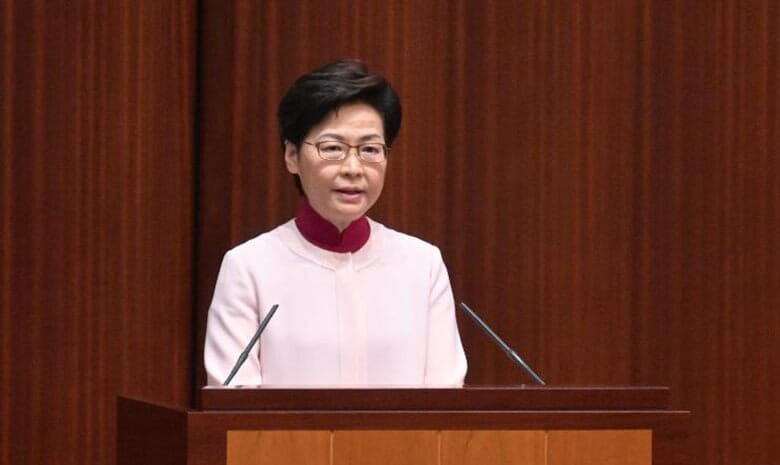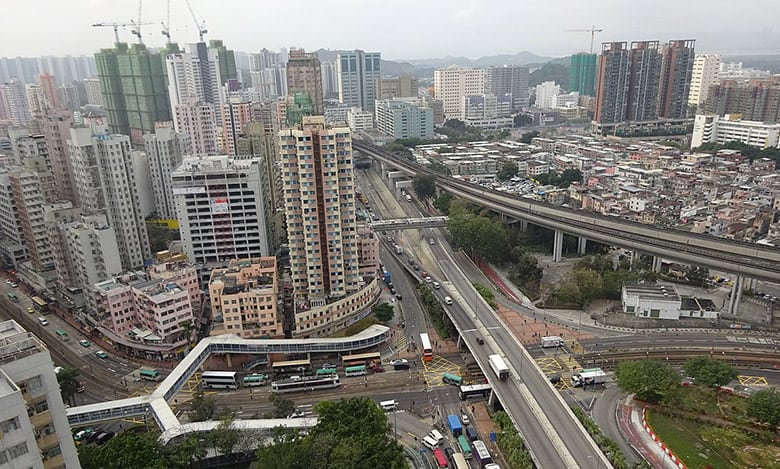
Carrie Lam delivering her last Policy Address today
In the final Policy Address of her current term as Hong Kong’s chief executive, Carrie Lam put housing and land supply issues front and centre, shining the spotlight on a lofty proposal to transform the city’s northern reaches into a new metropolis providing needed living space.
Spanning 300 square kilometres (116 square miles), the Northern Metropolis would include the Yuen Long and North districts in the New Territories and follow the Shenzhen-Hong Kong Boundary Control Points Economic Belt from west to east, Lam said in the Wednesday-morning speech.
Observers had expected Lam to lay out a plan to solve the local housing crunch, and the city’s leader made her case with detailed figures and a bold vision for “the most vibrant area where urban development and major population growth of Hong Kong in the next 20 years will take place”.
“Upon the full development of the entire Northern Metropolis, a total of 905,000 to 926,000 residential units, including the existing 390,000 residential units in Yuen Long District and North District, will be available to accommodate a population of about 2.5 million,” said Lam, who has remained coy about whether she plans to seek a second five-year term in office.
Decent Digs for All
In terms of the broader housing shortage in Hong Kong, Lam reiterated that the solution rested not on “quick fixes” but rather on the determination to sustain land supply and remain steadfast with policies in the face of short-term economic changes or fluctuations in property prices.

The govenment is betting on Yuen Long and the northern New Territories for development
She noted that officials have identified about 350 hectares (865 acres) of land to produce 330,000 public housing units for the coming 10‑year period (to 2032) — slightly higher than the figure announced last year and sufficient to meet the estimated public housing demand of 301,000 units during the period.
But the production of over 300,000 units in the decade ahead is to be “back-loaded”, with just a third of them delivered within the first five years.
“Providing decent accommodation for all is the primary goal of my housing policy,” Lam declared, sounding not quite like a politician ready to bow out of the scene.
Push Wins Praise
Analysts and valuers at Hong Kong’s top real estate agencies gave a measured response to the policy address, tempering their high marks with suggestions of their own.

CK Lau of Colliers International acknowledged the near term need for housing
CK Lau, managing director of Asia valuation and advisory services at Colliers, acknowledged the government’s “determination” to accelerate land supply and tackle the long-standing housing problem.
“Whilst the government has various long-term plans like the North Metropolis Development, Lantau Tomorrow Vision and large-scale railway projects, Hong Kong does need short-term measures to boost up land supply,” Lau said, making reference to a long-gestating Lam initiative that would create a new metropolis on artificial islands offshore of Lantau Island.
He praised the government’s push to unlock more rural land in the New Territories for development, while adding that the action plans and time schedule put forward had given further confidence to the market for their actual implementation.
Alkan Au, senior director of valuation advisory services at JLL Hong Kong, praised the government’s “decisive approach” towards efforts to increase the land supply. But he warned that much would depend on whether the related government departments could implement and revise regulations.
“If they revise the regulations, we estimate it will take at least three to five years to convert a plot into a residential site ready for development,” Au said. “As such, the land supply in the next three to five years will continue to rely on the URA, MTRC and private market.”
He also recommended the government lower the threshold for compulsory sales of old buildings, arguing that it would lower the cost of such acquisitions, shorten the acquisition period and speed up the redevelopment of old districts.
Timing of the Essence
Rita Wong, executive director and head of valuation and consulting for Greater China at CBRE, deemed it a “positive move” for the government to address sustainable long-term land supply and unlock development potential in the northern part of the New Territories.

Rita Wong of CBRE
The proposed Northern Metropolis would create a critical mass and a bigger community for residents to live and work in, she said, but making the land available would take a long time.
“Timing as to when this land supply of such a large-scale proposed metropolitan hub can be materialised will influence market pricing,” Wong said. “Well-planned infrastructure and amenities for sustainable growth are also crucial to the success in facilitating various business and economic functions.”
She voiced doubts about whether the supply of new land would be sufficient to meet housing demand and stabilise home price growth, as success would hinge on future immigration policy and demand from cross-border migration and investors.
“All in all, in the immediate to short-term speaking, we do not see any big impact on how the plan will help stabilise home price growth from this Policy Address,” Wong said.
Charles Chan, managing director of valuation and professional services at Savills Hong Kong, said he believed that the development strategy outlined by Lam could have “an immediate cooling impact” on the city’s red-hot residential property market.
He echoed Au’s call to lower the compulsory sale threshold and said the government’s ability to execute its land-use strategy would be critical.
“The government should propose a development blueprint and schedule as soon as possible to reassure the general public that the land supply will be available to the market in the near future so that they do not need to rush to purchase property,” Chan said.
Leave a Reply